Daily News
by Gail Helmer
[ Send Us News | Archives ]
Delta Force Black Hawk Down SP Demo
Delta Force - Black Hawk Down lets you experience missions similar to those encountered by U.S. Special Operations Forces during 10 months in Somalia. 3DGamers has posted the download.
C&C Generals Goes Beta
Electronic Arts announced today that its 3D real-time strategy game, Command & Conquer Generals has hit its beta milestone, and will ship to stores Feb. 11, 2003.
"The beta milestone is a tremendous achievement for the development team," said Mark Skaggs, general manager of EA Pacific and executive in charge of production for Command & Conquer Generals. "More than 50 of our industry's top talent have been working non-stop for the past several months to ensure that we have a solid, highly-polished, immensely-enjoyable game.
EA is currently conducting a public multiplay test of Command & Conquer Generals, involving more than 3,000 people around the world. The public test is giving participants a chance to play the game's multiplay mode via the Internet, includes five maps, and allows gamers to play as each of the three unique sides in the game.
"The community's feedback from the multiplay test was instrumental in helping us achieve this beta milestone," continued Mark Skaggs. "I do want to stress that we will continue to solicit their feedback to further balance and enhance the multiplay experience before shipping to stores."
Command & Conquer Generals puts players' trigger fingers on the pulse of modern warfare as they become a powerful general and control massive armies of bleeding-edge military weaponry across a globe teetering on the brink of Armageddon. Three unique sides will be available, each with customizable high-tech arsenals ready to deliver unprecedented firepower on land or in the skies. Players can annihilate the opposition in the 23-mission single-player campaign or dish out the damage in global multiplayer mayhem.
Do Real Pilots Prefer IL-2 Sturmovik?
The IL-2 Sturmovik website recently ran a poll of its readers:
"Do you have a Pilot's licence?"
5347 votes were cast as follows:
Yes - 23.5% = 1257 votes
No - 76.5% = 4090 votes
IL-2's Poll Forum Discussion
Updated Min Specs for LO:MAC
New LO:MAC Screenshots
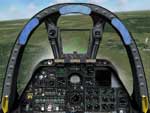
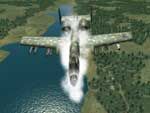
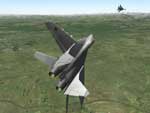
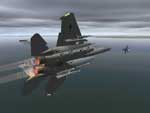
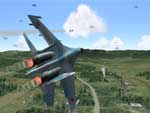
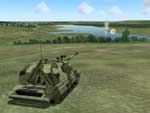
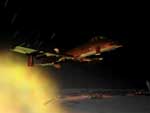
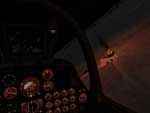
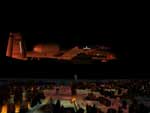
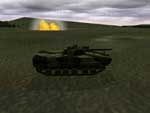
Military News
Blue Angels Commence Winter Training
From Blue Angels Public Affairs
NAVAL AIR STATION PENSACOLA, Fla. (NNS) -- The Navy Flight Demonstration Squadron, the Blue Angels, made its annual deployment to Naval Air Facility (NAF) El Centro, Calif., to prepare for the 2003 show season. The 10-week winter training concludes in early March after the team completes a minimum of 120 flights during a rigorous six-days-a-week, three-flights-per-day schedule.
The team performs its first public flight demonstration of 2003 at the El Centro base March 15 and will conclude the season Nov. 8 at Naval Air Station Pensacola. The Blue Angels will perform 70 shows at 34 locations throughout the United States and Canada during the 2003 season.
Boeing Demonstrates New Network-Centric Warfare Capability
ST. LOUIS, Jan. 9, 2003 – As part of its Weapon System Open Architecture, or WSOA, program, The Boeing Company has demonstrated an internet-like connection – between a command and control-type aircraft and a strike fighter – that allows real-time airborne collaboration for strikes on time-critical targets.
The demonstration was performed by the Boeing F-15E1 Advanced Technology Demonstrator and 737 Avionics Flying Laboratory equipped for command and control, or C2, operations. Aircraft operators shared and annotated target images and intelligence data in real time, using the Department of Defense's Link-16 tactical data link. This allowed the operators to respond to an emerging threat by successfully re-planning a mission during flight.
"Employing Weapon System Open Architecture technology will provide the same level of confidence in dynamic target scenarios as in pre-planned scenarios against fixed targets," said Dr. David Corman, WSOA program manager in Network Centric Operations of Boeing Phantom Works. "It also provides the foundation for connecting current weapon systems to the evolving network-centric battlespace."
An objective of the WSOA program is to demonstrate how mission critical information can be quickly exchanged between strike and C2 platforms in the prosecution of time critical targets by employing quality of service based resource management technologies enabled by open systems.
With WSOA technology integrated into the F-15, the weapon system operator was able to quickly select and download target images and re-plan the mission based on targeting imagery, threat locations provided by a Joint Tactical Terminal, and routing data passed by the C2 platform.
"Useable target imagery was received within the first 20 seconds, and there was no doubt about the target's location," said Rick Junkin, Boeing F-15 weapon systems officer on the flight.
The Weapon System Open Architecture program was awarded in 1999 to Boeing Phantom Works and partners Washington University, BBN Technologies and Honeywell in 1999. Phantom Works is the advanced Research and Development unit of The Boeing Company, serving as the catalyst for innovation for the enterprise.
The Weapon System Open Architecture program is managed by the Air Force Research Laboratory – Information Directorate. The program is sponsored by the Computer Resources Support Improvement Program, Defense Advanced Research Projects Agency, Open Systems Joint Task Force and the Joint Tactical Terminal Program Office.
Rolls-Royce Awards JSF Contract to Philips Aerospace
INDIANAPOLIS, Rolls-Royce has today (9 January 2003) placed a contract with Philips Aerospace of the Netherlands for the supply of fan cases for the F136 engine, which is being designed with General Electric to power the Lockheed Martin F-35 Joint Strike Fighter (JSF).
The contract cements the relationship between Rolls-Royce and Philips Aerospace for the F136 program which began with the signature of a Memorandum of Understanding between the two companies at the Paris Air Show in 1999.
Tom Hartmann, Vice President of JSF F136 Program, Rolls-Royce said: "Philips are bringing the expertise of high-technology, high-volume manufacture to the aerospace sector and this will help us to develop an excellent technical design that is cost effective and affordable."
"This order illustrates our long running commitment to industry in The Netherlands and Philips Aerospace will now lead a group of companies and institutions involved in the JSF F136 program. This approach will ensure that Rolls-Royce and the group members will work effectively in a team environment with ease of communication and exchange of information as the key," he added.
Philips Aerospace CEO, Kees de Korver added: "This order marks the beginning of our JSF relationship, which will build towards an effective and affordable F136 engine, and proves the confidence of Rolls-Royce in Philips Aerospace."
The GE/Rolls-Royce F136 Fighter Engine Team comprises: GE Aircraft Engines in Cincinnati, Ohio, Rolls-Royce Corporation in Indianapolis, Indiana and Rolls-Royce plc in Bristol, England.
The development of the 40,000-pound thrust class F136 engine under contract for the Joint Strike Fighter Program (JSF) is a cornerstone of future defense capability for the United States, the United Kingdom and their allied partners.
The first full F136 engine will go on test in 2004 and production engines will be available from 2010 in time for all International requirements.
Work-share split in the joint company is 60 percent for GE and 40 percent for Rolls-Royce.
GE Aircraft Engines (GEAE), with responsibility for 60 percent of the program, is developing the core-compressor, coupled turbine system, and the augmentor. Rolls-Royce, with 40 percent of the program, is responsible for the fan, combustor, low pressure turbine, and gearbox. Philips Aerospace will provide propulsion system components. FiatAvio is responsible for structural components for the low-pressure turbine and will participate in the development of the accessory gearbox.
The F136 engine incorporates advanced technology and processes that GEAE and Rolls-Royce obtained from the highly successful IHPTET (Integrated High Performance Turbine Engine Technology) and UK Technology Demonstrator programs. These technologies mean that F136 customers will benefit from better reliability, maintainability and cost benefits.
GEAE and Rolls-Royce are currently engaged in development work under the four-year, Phase III JSF program. This pre-System and Development Demonstration (SDD) phase, performed under a $411 million contract, runs through 2005.
During Phase III, the F136 engines will be tested for the various JSF variants: Short Takeoff Vertical Landing (STOVL) for the U.S. Marine Corps, U.K. Royal Navy and Royal Air Force, Conventional Takeoff/Landing (CTOL) for the U.S. Air Force, and the Carrier Variant (CV) for the U.S. Navy.
[ Send Us News | Archives ]
by Gail Helmer
Thursday, January 09, 2003
- Delta Force Black Hawk Down SP Demo
- C&C Generals Goes Beta
- Do Real Pilots Prefer IL-2 Sturmovik?
- Updated Min Specs for LO:MAC
- New LO:MAC Screenshots
- Blue Angels Commence Winter Training
- Boeing Demonstrates New Network-Centric Warfare Capability
- Rolls-Royce Awards JSF Contract to Philips Aerospace
Delta Force Black Hawk Down SP Demo
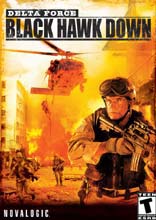 |
| Novalogic's Black Hawk Down |
Delta Force - Black Hawk Down lets you experience missions similar to those encountered by U.S. Special Operations Forces during 10 months in Somalia. 3DGamers has posted the download.
C&C Generals Goes Beta
Electronic Arts announced today that its 3D real-time strategy game, Command & Conquer Generals has hit its beta milestone, and will ship to stores Feb. 11, 2003.
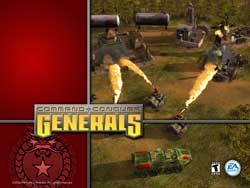 |
| C&C Generals |
"The beta milestone is a tremendous achievement for the development team," said Mark Skaggs, general manager of EA Pacific and executive in charge of production for Command & Conquer Generals. "More than 50 of our industry's top talent have been working non-stop for the past several months to ensure that we have a solid, highly-polished, immensely-enjoyable game.
EA is currently conducting a public multiplay test of Command & Conquer Generals, involving more than 3,000 people around the world. The public test is giving participants a chance to play the game's multiplay mode via the Internet, includes five maps, and allows gamers to play as each of the three unique sides in the game.
"The community's feedback from the multiplay test was instrumental in helping us achieve this beta milestone," continued Mark Skaggs. "I do want to stress that we will continue to solicit their feedback to further balance and enhance the multiplay experience before shipping to stores."
Command & Conquer Generals puts players' trigger fingers on the pulse of modern warfare as they become a powerful general and control massive armies of bleeding-edge military weaponry across a globe teetering on the brink of Armageddon. Three unique sides will be available, each with customizable high-tech arsenals ready to deliver unprecedented firepower on land or in the skies. Players can annihilate the opposition in the 23-mission single-player campaign or dish out the damage in global multiplayer mayhem.
Do Real Pilots Prefer IL-2 Sturmovik?
The IL-2 Sturmovik website recently ran a poll of its readers:
"Do you have a Pilot's licence?"
5347 votes were cast as follows:
Yes - 23.5% = 1257 votes
No - 76.5% = 4090 votes
IL-2's Poll Forum Discussion
Updated Min Specs for LO:MAC
- Windows(r)98/ME/XP Only
- Pentium III 800/AMD Athlon 600 or better
- 256 MB RAM (512 MB RAM recommended)
- 3D video card (DirectX 8.1 compatible) w/16MB RAM (32MB recommended)
- Sound Card (Direct 8.1 compatible)
- DirectX 8.1 or higher (included on disc)
- 4X CD-ROM or better (Not recommended for use with CD-RWs)
- Internet connection (56 kbps or better) or LAN for multiplayer
- Hard Drive Space 900+ MB
New LO:MAC Screenshots










Military News
Blue Angels Commence Winter Training
From Blue Angels Public Affairs
NAVAL AIR STATION PENSACOLA, Fla. (NNS) -- The Navy Flight Demonstration Squadron, the Blue Angels, made its annual deployment to Naval Air Facility (NAF) El Centro, Calif., to prepare for the 2003 show season. The 10-week winter training concludes in early March after the team completes a minimum of 120 flights during a rigorous six-days-a-week, three-flights-per-day schedule.
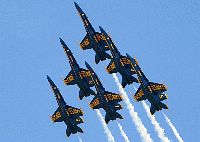 |
| The Navy's Blue Angels |
The team performs its first public flight demonstration of 2003 at the El Centro base March 15 and will conclude the season Nov. 8 at Naval Air Station Pensacola. The Blue Angels will perform 70 shows at 34 locations throughout the United States and Canada during the 2003 season.
Boeing Demonstrates New Network-Centric Warfare Capability
ST. LOUIS, Jan. 9, 2003 – As part of its Weapon System Open Architecture, or WSOA, program, The Boeing Company has demonstrated an internet-like connection – between a command and control-type aircraft and a strike fighter – that allows real-time airborne collaboration for strikes on time-critical targets.
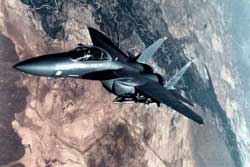 |
| F-15E1 Technology Demonstrator |
The demonstration was performed by the Boeing F-15E1 Advanced Technology Demonstrator and 737 Avionics Flying Laboratory equipped for command and control, or C2, operations. Aircraft operators shared and annotated target images and intelligence data in real time, using the Department of Defense's Link-16 tactical data link. This allowed the operators to respond to an emerging threat by successfully re-planning a mission during flight.
"Employing Weapon System Open Architecture technology will provide the same level of confidence in dynamic target scenarios as in pre-planned scenarios against fixed targets," said Dr. David Corman, WSOA program manager in Network Centric Operations of Boeing Phantom Works. "It also provides the foundation for connecting current weapon systems to the evolving network-centric battlespace."
An objective of the WSOA program is to demonstrate how mission critical information can be quickly exchanged between strike and C2 platforms in the prosecution of time critical targets by employing quality of service based resource management technologies enabled by open systems.
With WSOA technology integrated into the F-15, the weapon system operator was able to quickly select and download target images and re-plan the mission based on targeting imagery, threat locations provided by a Joint Tactical Terminal, and routing data passed by the C2 platform.
"Useable target imagery was received within the first 20 seconds, and there was no doubt about the target's location," said Rick Junkin, Boeing F-15 weapon systems officer on the flight.
The Weapon System Open Architecture program was awarded in 1999 to Boeing Phantom Works and partners Washington University, BBN Technologies and Honeywell in 1999. Phantom Works is the advanced Research and Development unit of The Boeing Company, serving as the catalyst for innovation for the enterprise.
The Weapon System Open Architecture program is managed by the Air Force Research Laboratory – Information Directorate. The program is sponsored by the Computer Resources Support Improvement Program, Defense Advanced Research Projects Agency, Open Systems Joint Task Force and the Joint Tactical Terminal Program Office.
Rolls-Royce Awards JSF Contract to Philips Aerospace
INDIANAPOLIS, Rolls-Royce has today (9 January 2003) placed a contract with Philips Aerospace of the Netherlands for the supply of fan cases for the F136 engine, which is being designed with General Electric to power the Lockheed Martin F-35 Joint Strike Fighter (JSF).
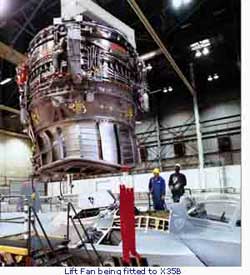 |
| Joint Strike Fighter |
The contract cements the relationship between Rolls-Royce and Philips Aerospace for the F136 program which began with the signature of a Memorandum of Understanding between the two companies at the Paris Air Show in 1999.
Tom Hartmann, Vice President of JSF F136 Program, Rolls-Royce said: "Philips are bringing the expertise of high-technology, high-volume manufacture to the aerospace sector and this will help us to develop an excellent technical design that is cost effective and affordable."
"This order illustrates our long running commitment to industry in The Netherlands and Philips Aerospace will now lead a group of companies and institutions involved in the JSF F136 program. This approach will ensure that Rolls-Royce and the group members will work effectively in a team environment with ease of communication and exchange of information as the key," he added.
Philips Aerospace CEO, Kees de Korver added: "This order marks the beginning of our JSF relationship, which will build towards an effective and affordable F136 engine, and proves the confidence of Rolls-Royce in Philips Aerospace."
The GE/Rolls-Royce F136 Fighter Engine Team comprises: GE Aircraft Engines in Cincinnati, Ohio, Rolls-Royce Corporation in Indianapolis, Indiana and Rolls-Royce plc in Bristol, England.
The development of the 40,000-pound thrust class F136 engine under contract for the Joint Strike Fighter Program (JSF) is a cornerstone of future defense capability for the United States, the United Kingdom and their allied partners.
The first full F136 engine will go on test in 2004 and production engines will be available from 2010 in time for all International requirements.
Work-share split in the joint company is 60 percent for GE and 40 percent for Rolls-Royce.
GE Aircraft Engines (GEAE), with responsibility for 60 percent of the program, is developing the core-compressor, coupled turbine system, and the augmentor. Rolls-Royce, with 40 percent of the program, is responsible for the fan, combustor, low pressure turbine, and gearbox. Philips Aerospace will provide propulsion system components. FiatAvio is responsible for structural components for the low-pressure turbine and will participate in the development of the accessory gearbox.
The F136 engine incorporates advanced technology and processes that GEAE and Rolls-Royce obtained from the highly successful IHPTET (Integrated High Performance Turbine Engine Technology) and UK Technology Demonstrator programs. These technologies mean that F136 customers will benefit from better reliability, maintainability and cost benefits.
GEAE and Rolls-Royce are currently engaged in development work under the four-year, Phase III JSF program. This pre-System and Development Demonstration (SDD) phase, performed under a $411 million contract, runs through 2005.
During Phase III, the F136 engines will be tested for the various JSF variants: Short Takeoff Vertical Landing (STOVL) for the U.S. Marine Corps, U.K. Royal Navy and Royal Air Force, Conventional Takeoff/Landing (CTOL) for the U.S. Air Force, and the Carrier Variant (CV) for the U.S. Navy.
